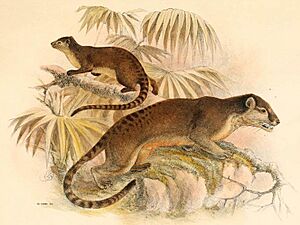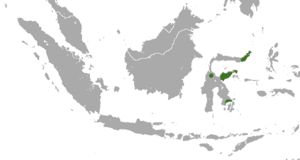Sulawesi palm civet facts for kids
Quick facts for kids Sulawesi palm civet |
|
|---|---|
 |
|
| Conservation status | |
| Scientific classification | |
| Genus: |
Macrogalidia
|
| Species: |
musschenbroekii
|
 |
|
| Sulawesi palm civet range | |
The Sulawesi palm civet (Macrogalidia musschenbroekii) is a special animal found only on the island of Sulawesi in Indonesia. It's also called the Sulawesi civet, musang, or brown palm civet. This animal is a type of mammal known as a viverrid, which are often cat-like creatures.
Sadly, the Sulawesi palm civet is listed as a Vulnerable animal. This means its numbers are going down. Experts believe its population has dropped by more than 30% in the last 15 years. This is mainly because its natural home is being destroyed or damaged. The Sulawesi palm civet is the only meat-eating mammal that lives naturally on Sulawesi.
What Does the Sulawesi Palm Civet Look Like?
The Sulawesi civet has soft, short fur that is light brownish-chestnut in color. Many lighter hairs are mixed in, making its coat unique. Its belly can be yellowish-brown to white, and its chest is reddish.
It has two faint stripes along its back and some light spots near its tail. Its whiskers are a mix of brown and white. The tail has dark and light brown rings that are not very clear underneath and disappear towards the dark tip.
From its head to its body, it measures about 89 centimeters (35 inches) long. Its tail adds another 64 centimeters (25 inches) to its length.
Where Do Sulawesi Palm Civets Live?
Sulawesi palm civets have been seen in many different places. They live in lowland forests, as well as forests higher up in the mountains, even at elevations of up to 2,600 meters (about 8,500 feet). They can also be found in grasslands and sometimes near farms.
These civets seem to prefer forests more than farm areas. While they can probably live in places where their habitat has been a little disturbed, they need tall forests to survive and thrive.
Between 2016 and 2017, these civets were spotted in Bogani Nani Wartabone National Park and in Tangkoko Batuangus Nature Reserve. These sightings were at elevations between 253 and 1,515 meters (830 to 4,970 feet).
How Do Sulawesi Palm Civets Live?
Sulawesi palm civets are partly arboreal, meaning they spend some of their time in trees. They are also nocturnal, which means they are most active at night.
They are omnivorous, eating both plants and animals. Their diet includes small mammals, fruits, and grass. Sometimes, they might also eat birds or small farm animals. Each civet might use an area of about 150 hectares (about 0.6 square miles) as its home range.


